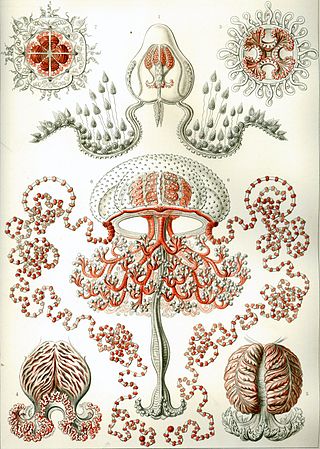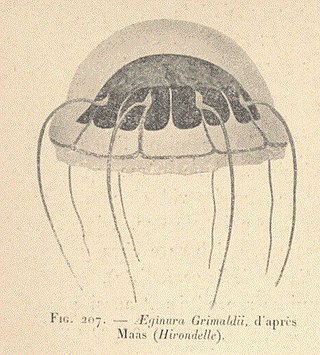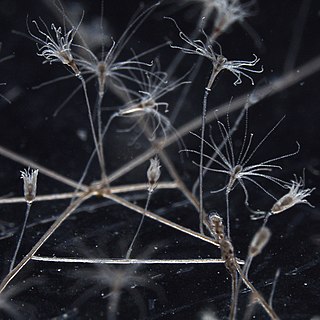
Hydrozoa is a taxonomic class of individually very small, predatory animals, some solitary and some colonial, most of which inhabit saline water. The colonies of the colonial species can be large, and in some cases the specialized individual animals cannot survive outside the colony. A few genera within this class live in freshwater habitats. Hydrozoans are related to jellyfish and corals, which also belong to the phylum Cnidaria.

Obelia is a genus of hydrozoans, a class of mainly marine and some freshwater animal species that have both polyp and medusa stages in their life cycle. Hydrozoa belongs to the phylum Cnidaria, which are aquatic organisms that are relatively simple in structure with a diameter around 1mm. There are currently 120 known species, with more to be discovered. These species are grouped into three broad categories: O. bidentata, O. dichotoma, and O. geniculata. O. longissima was later accepted as a legitimate species, but taxonomy regarding the entire genus is debated over.

Velella is a monospecific genus of hydrozoa in the Porpitidae family. Its only known species is Velella velella, a cosmopolitan free-floating hydrozoan that lives on the surface of the open ocean. It is commonly known by the names sea raft, by-the-wind sailor, purple sail, little sail, or simply Velella.

Turritopsis dohrnii, also known as the immortal jellyfish, is a species of small, biologically immortal jellyfish found worldwide in temperate to tropic waters. It is one of the few known cases of animals capable of reverting completely to a sexually immature, colonial stage after having reached sexual maturity as a solitary individual.

Anthoathecata, or the athecate hydroids, are an order of hydrozoans belonging to the phylum Cnidaria. A profusion of alternate scientific names exists for this long-known and heavily discussed group. It has also been called Gymnoblastea and, Anthomedusa, Athecata, Hydromedusa, and Stylasterina. There are about 1,200 species worldwide.

Hydroidolina is a subclass of Hydrozoa and makes up 90% of the class. Controversy surrounds who the sister groups of Hydroidolina are, but research has shown that three orders remain consistent as direct relatives: Siphonophorae, Anthoathecata, and Leptothecata.

Leptothecata, or thecate hydroids, are an order of hydrozoans in the phylum Cnidaria. Their closest living relatives are the athecate hydroids, which are similar enough to have always been considered closely related, and the very apomorphic Siphonophorae, which were placed outside the "Hydroida". Given that there are no firm rules for synonymy for high-ranked taxa, alternative names like Leptomedusa, Thecaphora or Thecata, with or without the ending emended to "-ae", are also often used for Leptothecata.

Porpita porpita, or the blue button, is a marine organism consisting of a colony of hydroids found in the warmer, tropical and sub-tropical waters of the Pacific, Atlantic, and Indian oceans, as well as the Mediterranean Sea and eastern Arabian Sea. It was first identified by Carl Linnaeus in 1758, under the basionym Medusa porpita. In addition, it is one of the two genera under the suborder Chondrophora, which is a group of cnidarians that also includes Velella. The chondrophores are similar to the better-known siphonophores, which includes the Portuguese man o' war, or Physalia physalis. Although it is superficially similar to a jellyfish, each apparent individual is actually a colony of hydrozoan polyps. The taxonomic class, Hydrozoa, falls under the phylum Cnidaria, which includes anemones, corals, and jellyfish, which explains their similar appearances.

Cladonematidae is a small family of anthomedusan hydrozoans. They have stolonal hydroid colonies, and their medusae are benthic and can crawl across the sediment; in many species they have lost the ability to swim however.

Bougainvillia muscus is a marine invertebrate, a species of hydroid in the suborder Anthomedusae.

Bougainvillia britannica is a marine invertebrate, a species of hydroid in the suborder Anthomedusae.

Bougainvillia is a genus of hydroids in the family Bougainvilliidae in the class Hydrazoa. Members of the genus are characterised by having the marginal tentacles of their medusae arranged in four bundles. Some species are solitary and others are colonial but all are filter feeders. They are found in the Southern Ocean, having a circumpolar distribution, but some species also occur in the Northern Hemisphere, possibly travelling there as polyps on the hulls of ships.

Eudendrium ramosum, sometimes known as the tree hydroid, is a marine species of cnidaria, a hydroid (Hydrozoa) in the family Eudendriidae of the order Anthoathecata.
Maeotias is a genus of hydrozoans in the family Olindiidae. It is a monotypic genus with only a single species, Maeotias marginata, commonly known as the Black Sea jellyfish or brackish water hydromedusa and often referred to as Maeotias inexpectata in the literature. It was first described from the Don and Kuban estuaries of the Sea of Azov, and also occurs in the Black Sea, all of which are areas of low salinity. It has been recorded in several other estuarine locations around the world and is regarded as an invasive species.

Porpita prunella is a marine species of hydrozoan organisms within the family Porpitidae. It consists of colonies of zooids. Very little is known about this species, as there have been no confirmed sightings since its discovery in 1801 and naming by Haeckel in 1888. Being in the chondrophore group, it is likely that its behaviour is similar to the other species of the genera in the family. However there are also serious doubts as to its very existence as a separate species and may in fact be a synonym for Porpita porpita instead.

Aeginura grimaldii is a species of deep sea hydrozoan of the family Aeginidae. It is found in the north-eastern Atlantic Ocean, Pacific Ocean, and the Arctic Ocean. It has a depth range of 660-1200m deep. Live specimens are bright reddish in color, with pale tentacles, and a light red globous capsule dome containing the dark colored red body. It usually measures no more than 4.5cm from the peak of the bell to the end of the tentacles.

Clava is a monotypic genus of hydrozoans in the family Hydractiniidae. It contains only one accepted species, Clava multicornis. Other names synonymous with Clava multicornis include Clava cornea, Clava diffusa, Clava leptostyla, Clava nodosa, Clava parasitica, Clava squamata, Coryne squamata, Hydra multicornis, and Hydra squamata. The larvae form of the species has a well developed nervous system compared to its small size. The adult form is also advanced due to its ability to stay dormant during unfavorable periods.

Zancleidae is a family of cnidarians belonging to the order Anthoathecata.

Rosalindidae is a family of cnidarians belonging to the order Anthoathecata.

The epibiotic hydroid is a benthic species within the Cnidaria phylum which is distributed throughout the Western Atlantic Ocean.
















